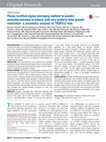Papers by Federico Prefumo

Zeitschrift für Geburtshilfe und Neonatologie, 2015
BACKGROUND: Phase-rectified signal averaging, an innovative signal processing technique, can be u... more BACKGROUND: Phase-rectified signal averaging, an innovative signal processing technique, can be used to investigate quasi-periodic oscillations in noisy, nonstationary signals that are obtained from fetal heart rate. Phase-rectified signal averaging is currently the best method to predict survival after myocardial infarction in adult cardiology. Application of this method to fetal medicine has established significantly better identification than with short-term variation by computerized cardiotocography of growth-restricted fetuses. OBJECTIVE: The aim of this study was to determine the longitudinal progression of phase-rectified signal averaging indices in severely growthrestricted human fetuses and the prognostic accuracy of the technique in relation to perinatal and neurologic outcome. STUDY DESIGN: Raw data from cardiotocography monitoring of 279 human fetuses were obtained from 8 centers that took part in the multicenter European "TRUFFLE" trial on optimal timing of delivery in fetal growth restriction. Average acceleration and deceleration capacities were calculated by phase-rectified signal averaging to establish progression from 5 days to 1 day before delivery and were compared with short-term variation progression. The receiver operating characteristic curves of average acceleration and deceleration capacities and short-term variation were calculated and compared between techniques for short-and intermediate-term outcome. RESULTS: Average acceleration and deceleration capacities and short-term variation showed a progressive decrease in their diagnostic indices of fetal health from the first examination 5 days before delivery to 1 day before delivery. However, this decrease was significant 3 days before delivery for average acceleration and deceleration capacities, but 2 days before delivery for short-term variation. Compared with analysis of changes in short-term variation, analysis of (delta) average acceleration and deceleration capacities better predicted values of Apgar scores <7 and antenatal death (area under the curve for prediction of antenatal death: delta average acceleration capacity, 0.62 [confidence interval, 0.19e1.0]; delta short-term variation, 0.54 [confidence interval, 0.13e0.97]; P¼.006; area under the curve for prediction Apgar <7: average deceleration capacity <24 hours before delivery, 0.64 [confidence interval, 0.52e0.76]; short-term variation <24 hours before delivery, 0.53 [confidence interval, 0.40e0.65]; P¼.015). Neither phase-rectified signal averaging indices nor short-term variation showed predictive power for developmental disability at 2 years of age (Bayley developmental quotient, <95 or <85). CONCLUSION: The phase-rectified signal averaging method seems to be at least as good as short-term variation to monitor progressive deterioration of severely growth-restricted fetuses. Our findings suggest that for short-term outcomes such as Apgar score, phase-rectified signal averaging indices could be an even better test than short-term variation. Overall, our findings confirm the possible value of prospective trials based on phase-rectified signal averaging indices of autonomic nervous system of severely growth-restricted fetuses.
Ultrasound in Obstetrics & Gynecology, Sep 8, 2016

Ultrasound in Obstetrics & Gynecology, 2022
OBJECTIVES To evaluate the diagnostic performance of third trimester ultrasound for the diagnosis... more OBJECTIVES To evaluate the diagnostic performance of third trimester ultrasound for the diagnosis of clinically significant Placenta accreta spectrum disorder (PAS) in women with a low-lying placenta (less than 20 mm from the internal cervical os) or placenta praevia (covering the os) METHODS: Pregnant women with a low-lying placenta or placenta praevia, age ≥ 18 years and gestational age at ultrasound ≥ 26+0/7 weeks of gestation were prospectively included in the study. Ultrasound suspicion of PAS was raised in the presence of at least one of these signs: (1) obliteration of the hypoechoic space between the uterus and the placenta; (2) interruption of the hyperechoic interface between the uterine serosa and the bladder wall; (3) abnormal placental lacunae. In order to assess the ability of ultrasound to detect clinically significant PAS, a composite outcome comprehensive of both active management at delivery and histopathological confirmation of PAS was considered as the reference standard. PAS was considered of clinical significance if, in addition to histological confirmation, at least one of these procedures was carried out after delivery: use of hemostatic intrauterine balloon, compressive uterine suture, peripartum hysterectomy, uterine/hypogastric artery ligation, uterine artery embolization. RESULTS A total of 568 women underwent transabdominal and transvaginal ultrasound examinations. Of them, 95 delivered in local hospitals and placental pathology according to the study protocol was therefore not available. Among the 473 for whom placental pathology was available, clinically significant PAS was diagnosed in 99 (21%). A normal hypoechoic space between the uterus and the placenta reduces post-test probability of PAS from 21% to 5% in women with a low-lying placenta or placenta previa in the third trimester of pregnancy, and from 62% to 9% in the subgroup of women with previous cesarean section and anterior placenta. The absence of lacunae reduces post-test probability of PAS from 21% to 9% in women with low-lying placenta or placenta previa in the third trimester of pregnancy, and from 62% to 36% in the subgroup with previous cesarean section and anterior placenta. On the other side, when lacunae are seen the post-test probability increases from 21% to 59% in the whole study population and from 62% to 78% in women with placenta previa, previous cesarean section and anterior placenta. CONCLUSIONS Grey-scale ultrasound is a good test to identify pregnancies at low risk of PAS in this high risk population. Ultrasound can be safely used to guide management decisions, concentrating greater resources in patients with the higher risk of clinically significant PAS This article is protected by copyright. All rights reserved.

European Journal of Obstetrics & Gynecology and Reproductive Biology, 2022
OBJECTIVES To investigate the association between chorionicity, birth weight discordance and neon... more OBJECTIVES To investigate the association between chorionicity, birth weight discordance and neonatal morbidity in uncomplicated twin pregnancies progressing to at least 36 weeks of gestation. STUDY DESIGN This was a retrospective single centre cohort study of all twin pregnancies referred to our twin clinic between 2011 and 2018. Outcome details were obtained from the computerized maternity and neonatal records. The primary outcome was incidence of composite neonatal morbidity according to chorionicity. We also determined the incidence of composite neonatal morbidity in pregnancies with birth weight discordance. Logistic regression was used to identify and adjust for potential confounders. RESULTS Three hundred and eighty-five twin pregnancies (286 dichorionic, 99 monochorionic) were included. Gestational age at birth was significantly lower in pregnancies complicated by neonatal morbidity (p = 0.013) compared with those which were not. On multivariable logistic regression analysis, gestational age at birth (p = 0.031) and birth weight discordance (p = 0.004), but not chorionicity (p = 0.626) were independently associated with neonatal morbidity. CONCLUSION(S) In uncomplicated twin pregnancies chorionicity is not associated with neonatal morbidity. Gestational age at birth is the major determinant of neonatal outcome while the clinical impact of weight discordance seems marginally significant.

Minerva Obstetrics and Gynecology, 2021
There is a strong but complex relationship between fetal growth restriction and pre-eclampsia. Ac... more There is a strong but complex relationship between fetal growth restriction and pre-eclampsia. According to the International Society for the Study of Hypertension in Pregnancy the co-existence of gestational hypertension and fetal growth restriction identifies pre-eclampsia with no need for other signs of maternal organ impairment. While early-onset fetal growth restriction and pre-eclampsia are often strictly associated, such association becomes looser in the late preterm and term periods. The incidence of pre-eclampsia decreases dramatically from early preterm fetal growth restriction (39-43%) to late preterm fetal growth restriction (9-32%) and finally to term fetal growth restriction (4-7%). Different placental and cardiovascular mechanism underlie this trend: isolated fetal growth restriction has less frequent placental vascular lesions than fetal growth restriction associated with pre-eclampsia; moreover, late preterm and term fetal growth restriction show different patterns of maternal cardiac output and peripheral vascular resistance in comparison with pre-eclampsia. Consequently, current strategies for first trimester screening of placental dysfunction, originally implemented for pre-eclampsia, do not perform well for late-onset fetal growth restriction: the sensitivity of first trimester combined screening for small-for-gestational age newborns delivered at less than 32 weeks is 56-63%, and progressively decreases for those delivered at 32-36 weeks (43-48%) or at term (21-26%). Moreover, while the test is more sensitive for small-forgestational age associated with pre-eclampsia at any gestational age, its sensitivity is much lower for small-for-gestational age without pre-eclampsia at 32-36 weeks (31-37%) or at term (19-23%).

International Journal of Gynecology & Obstetrics, 2021
OBJECTIVE To compare delivery outcomes between true positive (TP) and false positive (FP) LGA, ap... more OBJECTIVE To compare delivery outcomes between true positive (TP) and false positive (FP) LGA, appropriate for gestational age (AGA) and false negative LGA (FN LGA) fetuses. METHODS Retrospective cohort study of singleton pregnancies at risk for macrosomia without contraindication to vaginal delivery, receiving an ultrasound scan at 34-37 weeks. RESULTS 430 pregnancies were included: 155 TP LGA, 87 FP LGA and 177 AGA and 11 FN LGA newborns. Cesarean section rate during labour was significantly higher in FP LGA than in AGA (19% vs 8.7%) but not significantly different between FP LGA and TP LGA (19% vs 32.4%). Median birth weight z score was significantly higher in TP LGA (1.9) compared to the FP LGA and AGA (0.91 and 0.84, respectively), while no significant differences were found between FP LGA and AGA. Admission to neonatal intensive care unit was significantly more frequent in TP LGA than AGA, while shoulder dystocia, postpartum hemorrhage, and 3rd-4th degree perineal tears were similar between the different groups. CONCLUSION A false positive diagnosis of LGA fetus is associated with a significant increase of Cesarean section during labour. Therefore, a suspicious ultrasound may result in reduction of the clinical threshold for the diagnosis of abnormal labour.

Ultrasound in Obstetrics & Gynecology, 2020
ABSTRACTObjectivesTo assess the role of fetal magnetic resonance imaging (MRI) in detecting assoc... more ABSTRACTObjectivesTo assess the role of fetal magnetic resonance imaging (MRI) in detecting associated anomalies in fetuses presenting with mild or moderate isolated ventriculomegaly (VM) undergoing multiplanar ultrasound evaluation of the fetal brain.MethodsThis was a multicenter, retrospective, cohort study involving 15 referral fetal medicine centers in Italy, the UK and Spain. Inclusion criteria were fetuses affected by isolated mild (ventricular atrial diameter, 10.0–11.9 mm) or moderate (ventricular atrial diameter, 12.0–14.9 mm) VM on ultrasound, defined as VM with normal karyotype and no other additional central nervous system (CNS) or extra‐CNS anomalies on ultrasound, undergoing detailed assessment of the fetal brain using a multiplanar approach as suggested by the International Society of Ultrasound in Obstetrics and Gynecology guidelines for the fetal neurosonogram, followed by fetal MRI. The primary outcome of the study was to report the incidence of additional CNS anom...
Archives of Gynecology and Obstetrics, 2019

Ultrasound in Obstetrics & Gynecology, 2019
Objectives: To compare intrapartum Caesarean section (CS) incidence among pregnancies with true p... more Objectives: To compare intrapartum Caesarean section (CS) incidence among pregnancies with true positive (TP) large for gestational age (LGA) fetuses (estimated fetal weight or abdominal circumference > 90th percentile and birth weight > 90th percentile), false positives (FP, fetuses diagnosed antenatally as LGA but with birth weight < 90th percentile) and appropriate for gestational age (AGA) fetuses (AC, estimated fetal weight and birth weight between 50th and 90th percentile). Methods: Case-control study including single pregnancies without contraindication to vaginal delivery and excluding elective or urgent CS performed before labour. Neonatal biometric variables were transformed into Z scores to make them independent of gestational age. Continuous variables were compared by Mann-Whitney test/ Kruskal-Wallis test; nominal ones were compared by Fisher exact test/Chi-Square test. p-values < 0.05 were considered statistically significant. Results: 430 patients were included in the analysis: 169 TP LGA, 82 FP LGA and 179 AGA. The CS incidence in the FP group was significantly higher than in the AGA group (20.9% vs 8.8%; p < 0.014), but not significantly different from the LGA group (20.9% vs 27.5%) (p = 0.342). Labour duration was not significantly different in the 3 groups (p = 0.689). Birth weight was significantly higher in the TP LGA group (median 3980 g, Z score 1.879) compared to the FP LGA group (p < 0.0001) and AGA group (p < 0.0001). No significant differences were found between the FP LGA and AGA groups (median birth weigth 3525 g vs 3560 g, p = 0.269; z score 0.913 vs z score 0.864, p = 0.809). Conclusions: An incorrect diagnosis of LGA fetus is associated with a significant increase in CS during labour. The ultrasound suspicion of LGA could probably lead to the reduction of the clinical threshold for the diagnosis of abnormal labour.

Ultrasound in Obstetrics & Gynecology, 2019
Oral communication abstracts Methods: The study included 102 patients experiencing pregnancy loss... more Oral communication abstracts Methods: The study included 102 patients experiencing pregnancy loss at < 14 weeks. Blood samples were drawn for genome-wide cfDNA testing. Patients then underwent chorionic villous sampling (CVS) for karyotyping of both short-term and long-term cultures. Quantitative fluorescent PCR was also performed for some chromosomes. The first 50 cases served as a training set to determine appropriate thresholds for making an aneuploidy call. These were used for the entire cohort. Results: The mean gestational age at embryo demise was 9.8 ± 2.1 weeks and the fetal fraction was 5.2 ± 3.7%. A chromosomal anomaly was detected in 68 cases. The rates of chromosomal anomalies were 67%, 74%, 73% and 42% in patients undergoing their 1 st , 2 nd , 3 rd , and ≥4 th losses, respectively. Of the 54 cases with a single autosomal trisomy or monosomy X, the detection rate was 83%. Of the 14 cases with complex abnormalities, monosomy, triploidy or mosaic, only 2 were detected. There were 4 false positive cases. The overall sensitivity of cfDNA-based testing was 69%. Conclusions: We suggest that cfDNA-based testing serve to guide management in RPLs: if cfDNA in the 2nd and subsequent RPL demonstrates aneuploidy, no further action is taken; if cfDNA demonstrates an unbalanced rearrangement, parental karyotypes is recommended; and if no abnormality is detected, then the recommended RPL workup is performed.

Ultrasound in Obstetrics & Gynecology, 2019
Oral communication abstracts Objectives: To compare the different classifications in use for mull... more Oral communication abstracts Objectives: To compare the different classifications in use for mullerian anomalies (ASRM, Salim, ESHRE/ESGE, CUME) in the diagnosis of normal/ arcuate/ septate uterus and to correlate the diagnosis with reproductive outcomes. Methods: Retrospective observational study conducted on 664 patients with 3D ultrasound diagnosis of arcuate/subseptate uterus (3-30 mm indentation). For each patient the uterine morphology was evaluated offline on the coronal plane and the following measurements were recorded:-uterine cavity width (W); septal length (L); uterine wall thickness (M); fundal indentation angle (α). Each uterus was subsequently subclassified according to the following classifications: ASRM (1988), Salim (2003), ESHRE/ESGE (2013), CUME (2018). The reproductive history of each patient was correlated to the cavitary measurements and the type of malformation according to the four classifications. Results: 38% of patients were infertile, 62% had at least one pregnancy with 75% of abortion, 23% of secondary infertility and 13% of preterm labour. Primary infertility was greater in patients with narrow cavities (W), less uterine wall thickness (M) and greater indentation angle (α). Preterm birth was associated with longer septa (L), recurrent abortion with small and narrow septa (L, W). The current classifications are not homogeneous in the definition of subseptate uterus and are not correlated with reproductive outcomes. This correlation becomes significant by imposing an indentation cutoff ≥ 5mm to the ESHRE classification. Conclusions: According to our results the presence of a partial septum carries a negative effect on reproductive impacts. We identified certain uterine morphological features that seem to have a greater association with negative outcomes. Current classifications don't seem to correlate with reproductive outcomes. In our opinion, the determination of a minimum indentation cutoff could standardise the existing classifications by clearly defining the criteria for corrective surgery.
Ultrasound in Obstetrics & Gynecology, 2019
Short oral presentation abstracts and PAS 3 accounted for 3, 4 and 5 cases, respectively. All wom... more Short oral presentation abstracts and PAS 3 accounted for 3, 4 and 5 cases, respectively. All women were submitted to Caesarean section and hysterectomy was required in 10. The comparison of the perinatal outcomes among the PAS categories yielded significantly greater operative time and estimated blood loss for the highest PAS categories (p 0.001 for both), which were also associated with a significantly higher rate of hysterectomy (p < 0.001), intraoperative or postoperative transfusion (p 0.002), post-surgical admission to ITU or HDU (p < 0.001) and also associated with longer postoperative admission (p 0.02). Conclusions: The PAS scoring system retains its performance on external validation in the hands of ultrasound examiners with expertise in the evaluation of women at risk of abnormally invasive placenta.

Ultrasound in Obstetrics & Gynecology, 2019
Objectives: To investigate textural analyses as the radiomics in magnetic resonance (MR) imaging ... more Objectives: To investigate textural analyses as the radiomics in magnetic resonance (MR) imaging of the placenta in predicting of placenta accreta spectrum disorders (PAS) requiring Caesarean hysterectomy in a high-risk population. Methods: We performed a retrospective review of 51 pregnancies with prior Caesarean delivery referred for MRI from 2014-2018 because of sonographic suspicion for PAS. Placental regions of interest (ROIs) were generated on T2-weighted, diffusion-weighted images (DWI) and the DWI-derived apparent diffusion coefficient (ADC), based on definitions of areas of placenta in proximity to and remote from previous surgical incision sites. T-tests and chi-square analyses between the primary outcome (hysterectomy vs. no hysterectomy) were performed. 13 Haralick texture features calculated from gray-level co-occurrence matrixes were extracted from manually drawn placental ROIs within each of three MR acquisitions. Univariate logistic regression models tested the association between the primary outcome and the texture features. Results: Of 51 pregnancies at risk for PAS, 38 required Caesarean hysterectomy (75%), with excellent correlation between need for hysterectomy determined surgically and pathological confirmation of PAS in the hysterectomy specimen [κ=0.81(0.62, 1)]. Of the 13 Haralick texture features within each of 3 acquisition groups, significant differences were seen in 21 of 39 parameters comparing placental ROIs in proximity to incision scar(s) to those ROI's remote from scar(s). Stepwise selection algorithm indicated that the combination of several texture features (T2WF cm.joint.entr , T2WF cm.info.corr.2 , T2WF cm.joint.var , ADCF cm.sum.avg and ADCF cm.info.corr.2) gave the highest leave-one-out-AUC of 0.87 (0.80,1). Conclusions: We identified textural features on MR images of the placenta in the region of the prior uterine scar that differentiated pregnancies with invasion severe enough to require Caesarean hysterectomy from those that did not, suggesting predictive capabilities of these radiomics features.

Ultrasound in Obstetrics & Gynecology, 2019
Parma, Parma, Italy; 8Unit of Fetal Medicine and Prenatal Diagnosis, Institute for Maternal and C... more Parma, Parma, Italy; 8Unit of Fetal Medicine and Prenatal Diagnosis, Institute for Maternal and Child Health IRCCS Burlo Garofolo, Trieste, Italy; 9Department of Obstetrics and Gynaecology, Bolzano Hospital, Bolzano, Italy; 10Department of Biomedical, Experimental and Clinical Sciences, Division of Obstetrics and Gynecology, University of Firenze, Firenze, Italy; 11Department of Obstetrics and Gynecology, Buccheri La Ferla-Fatebenefratelli Hospital, Palermo, Italy; 12Department of Obstetrics and Gynecology, Ospedali Riuniti Villa Sofia Cervello, Palermo, Italy; 13Department of Obstetrics and Gynecology, Insubria University, Varese, Italy; 14Obstetrics and Gynecology Unit, Department of Medical and Surgical Sciences, University of Modena e Reggio Emilia, Modena, Italy; 15Fetal Medicine, UiT, University of Northern Norway, Tromsø, Norway; 16Department of Obstetrics and Gynecology, ARNAS Civico Palermo, Azienda Ospedali Riuniti Villa Sofia Cervello, Palermo, Italy

Ultrasound in Obstetrics & Gynecology, 2019
Electronic poster abstracts was also done personally at scientific meetings. Primary outcome was ... more Electronic poster abstracts was also done personally at scientific meetings. Primary outcome was to compare the proportion of GOs that consider the need of a third trimester ultrasound (estimation of fetal weight) for screening of FGR in low risk pregnancies and the best time to perform it with the corresponding proportion of GPs. Results: A total of 573 surveys were available for analysis, 298 corresponded to GOs and 275 to GPs. The vast majority of GOs and GPs (93%) considered that third trimester ultrasound is useful and needed for surveillance of low risk pregnancy. A higher proportion of GOs (38%) selected 35 th-37 th weeks as the best time to perform the ultrasound compared to GPs (10%) (p < 0.001). GOs (51%) consider that symphysis-fundus distance is a measurement with moderate accuracy for screening of FGR while GPs (61%) attribute a low accuracy (p < 0.001). Fifty percent (50%) of GOs consider that performing a third trimester ultrasound will have no impact on Caesarean delivery rate for fetal distress, while 41% of GPs consider that routine ultrasound will contribute to increase this rate (p < 0.001). The majority of GPs (52%) consider that routine ultrasound will contribute to diminish the admission rate to NICU while GOs revealed a dichotomy with 43% of respondents reporting that it will diminish the rate and 40% that it will have no impact. Conclusions: Varied opinions among the clinicians included in our sample reflect the controversy that remains on the best screening of FGR in low risk pregnancies. EP01.13 Importance of ultrasonographic cervical length around 20 weeks of gestation for predicting spontaneous preterm labour: an artificial neural network analysis
Ultrasound in Obstetrics & Gynecology, 2019
Ultrasound in Obstetrics & Gynecology, 2018

Acta Obstetricia et Gynecologica Scandinavica, 2018
IntroductionSpontaneous preterm birth in women with a twin pregnancy is one of the main causes of... more IntroductionSpontaneous preterm birth in women with a twin pregnancy is one of the main causes of perinatal mortality and morbidity. Our aim was to review the perinatal outcome of asymptomatic twin pregnancies with a sonographic short cervical length during the second trimester treated with an ultrasound‐indicated cerclage or cervical pessary.Material and methodsRetrospective study on asymptomatic twin pregnancies with a short cervix (≤ 25 mm) at transvaginal ultrasound examination during the second trimester treated with a cervical cerclage or pessary (2001‐2017). The rate of preterm birth < 28, 32 and 34 weeks of gestation, neonatal mortality, neonatal morbidity and composite adverse neonatal outcome were compared in the groups of women treated with cerclage or pessary.ResultsSeventy‐four twin pregnancies underwent a cerclage while a cervical pessary was inserted in 34 women with twins at our Department: 36 women with an ultrasound‐indicated cerclage and 20 with a pessary were ...
Ultrasound in Obstetrics & Gynecology, 2018

Ultrasound in Obstetrics & Gynecology, 2012
Poster abstracts newborn, umbilical artery power Doppler with zero or reverse enddiastolic blood ... more Poster abstracts newborn, umbilical artery power Doppler with zero or reverse enddiastolic blood flow (blood flow class IIIa/IIIb) or changes in venous duct blood flow. We collected data about pregnancy, prenatal ultrasound examinations and result of pregnancy. Results: 20 pregnancies were included. All women underwent caesarian section. Indication was severe maternal complication, worsening of power Doppler or deterioration of the fetus. 4 children died in postnatal period, 3 have some birth defects. Mean time of first ultrasound was 29+2g.w.11 fetuses had zero flow and 6 had reverse enddiastolic blood flow in umbilical artery. Mean estimated body weight was on 4.1 th centile, mean pulsatile index in umbilical artery 2.39 (SD0.32) and cerebroplacental ratio 0.65 (SD0.18). Mean gestation week at delivery 29+5g.w, fetal body weight 891 g, Apgar score at 5 th min 8, 10 th min 9, arterial pH7.25 (SD1.69) and venous pH7.3 (SD1.63). Conclusions: Management of perinatal care of early onset IUGR with signs of blood flow redistribution is based on values of pulsatile index of umbilical artery, medial cerebral artery, venous duct and its pattern. Extreme or severe prematurity and maternal hypertensive complication are important factors.











Uploads
Papers by Federico Prefumo
• La donna deve essere informata su scopi, implicazioni e limiti delle indagini ecografiche.
• In Italia vengono eseguite in media cinque ecografie ostetriche per ogni parto.
• Attualmente, non sono previsti o raccomandati in Italia programmi di controllo della qualità degli screening ecografici in gravidanza.